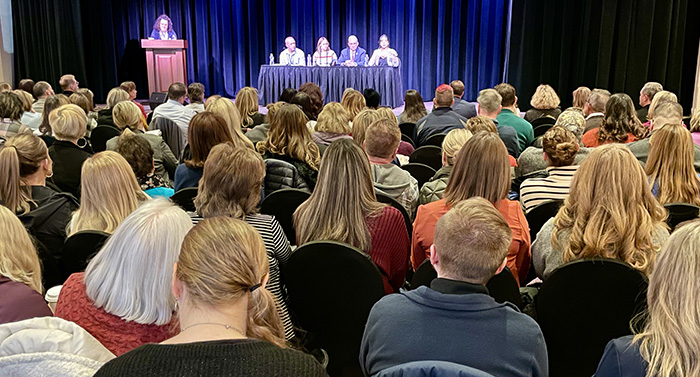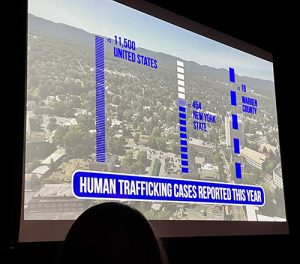By Cathy DeDe, Chronicle Managing Editor
A capacity crowd, 200 people, showed up for a panel on human trafficking at the local level, at the Park Theater on Thursday morning, Jan. 18.
In the audience: Community leaders including Glens Falls National Bank president Dave DeMarco, Warren County District Attorney Jason Carusone, Assemblymember Matt Simpson and numerous other elected officials, representatives of non-profit organizations, nurses and other health care professionals, parents and community members.

“I can’t recall the last time I was at an informational event where more than 200 people came out” — especially to learn about a difficult topic, said moderator Liza Ochsendorf, the Warren County Director of Workforce Development.
Retired Saratoga Springs police officer John Kelly, a former school resource officer now with the New York State Children’s Alliance, said, “This is a testament to this community to put the word out so well and fill a place like this.” He said he does many such programs elsewhere that don’t see such a turnout.
The eye-opening matter at hand: Human trafficking is happening in our community, particularly involving youths and children, “and it occurs on a regular basis,” said Elena Clayton, victim specialist with the Albany division of the FBI.
Jason McLaughlin, executive director of the WAIT House in Glens Falls, which serves homeless youths and parenting young people, defined human trafficking as “any time a young person provides sex or labor in exchange for goods or care, through force, fraud or coercion.”
Surprisingly, 88 percent of trafficking cases reported in New York State occured in upstate and rural communities, said Shannon Lukowski of the state Office of Children and Family Services.
She said her office saw 10 active cases of human trafficking in Warren County last year. An introductory video said 18 cases were reported in the county overall.
Ms. Clayton said “the common myth” that trafficking is about “young girls kidnapped and taken to a different country….That’s not it. They are our home-grown kids, and it happens here.”
Mr. McLaughlin said, “People are struggling, barely making ends meet, even middle class and upper middle class.
“It’s a volatile political climate. I can tell you, our kids (at the WAIT House) worry about these things a lot.
“A lot are in fight or flight mode, all the time. They will do what it takes to survive. 100 percent of our kids have some kind of trauma that is used against them. A lot of them, they’re not getting kicked out. They are leaving to get away from parents who are in crisis.”
“They can be couch surfing, or living through survival sex. Someone offers them phones, shoes, clothing. Then comes the time they have to pay it back.”

“When kids are desperate they do things they wouldn’t normally do,” Mr. McLaughlin said.
Mr. Kelly added, “A lot goes on that doesn’t get reported,” which he said can also hurt funding for anti-trafficking programs.
“These kids are being victimized,” Mr. Kelly said. “They’re ashamed, scared, intimidated.”
They can be as young as 13, “we’re even seeing 11 year olds,” the panel said.
“Trafficking is really a poor word,” Mr. Kelly said. “It makes it sound like a migrant issue. We are really talking about exploitation of our youth.”
It can take the form of sex, youths coerced to sell drugs, even to sell goods for fake fund-raisers, they said.
Mr. McLaughlin of the WAIT House said, “What I want to emphasize is, this is a business, and it is a large business, second only to drug trafficking. This is a very profitable business for many criminal organizations.”
“There’s a lot to be gained,” Mr. Kelly agreed.
“When we look at cartels and other crime organizations,” Mr. McLaughlin said, “like any other business, they like to diversify — with drugs, guns, human trafficking, he said.
“It’s tough to say this,” Mr. Kelly added: “You can sell a bag of cocaine once, but a human being 10 times in a day.”

He said, “They recruit children to do the dirty work for them, using things against them, and pay them very well — money, and things, and basic needs like a place to stay. It’s very tempting.”
“Perpetrators are good at enticing a person,” Ms. Clayton said. “They give them drugs, get them addicted, then exploit that and use it against them.”
“The victims often don’t realize they are being trafficked,” Ms. Lukowski said. “They think it’s just part of their everyday. They are having to find a way to survive.”
“Anyone is at risk,” she said. “Perpetrators do not discriminate: Male, female, transgender, wealthy, poor.”
“Traffickers are very intelligent people,” Mr. Kelly said. “I picture a lioness in the grass overlooking a herd of gazelles. She’s looking for the weak and injured. They are good at picking them out.”
“Perpetrators don’t look evil,” Ms. Clayton said. “They are very cunning and resourceful. They offer housing, they see who needs protection, or drugs.
“It’s called grooming, trying to gain trust with the youth,” she said.
“They look like normal people but they are cunning. Sometimes it’s a family member, a brother, a mother, a step parent,” Ms. Lukowski said. “That’s very tragic.”

Sometimes also, Ms. Clayton said, the immediate contact is with another trafficked person the perpetrators use as a go-between, to recruit more victims and insulate themselves from the law.
The panel said 75 percent met their trafficker online through social media, something they said that’s become even more prevalent post-Covid.
Challenges to reporting
The group talked about legal and government systems that depend on victims to testify, to tell their stories in order to convict perpetrators, but that police, courts, govenment programs can also be intimidating, and in some cases, have already failed the victims in other ways.
“Let the law enforcement do what it has to; we focus on healing,” Mr. Kelly said.
“At the FBI, we have a very victim centric approach,” Ms. Clayton assured.
What can be done?
Ms. Clayton emphasized, “Disclosure comes at a moment of vulnerablity. So, be engaged, be aware, and know where to report it. That’s what we are charging you with.”
Victims come forward when they feel safe, panelists said — after a school assembly, maybe in the doctor’s office.
Ms. Lukowski advised, educate youths as to healthy and unhealthy relationships, “about coercion and what consent is. Make it an open conversation, where nothing is taboo.”
“Keep kids safe online,” panelists said. Start as early as kids have phones, age 5, when the simple message might be, “Not everything someone says online is true.”
Mr. Kelly, the retired officer, said he realizes now that many youths he saw as troublemakers were likely victims. “They had every right to be angry or suspicious, but I didn’t see it.”
He says, “An officer gets a call to a hotel for a domestic incident, and the impulse is to look at it on face value. But if you ask questions, dig a little deeper, you realize something else is going on.”
“You see a young person slumped over the table, not taking care of themselves. Asking if they are okay can go a long way,” Ms. Lukowski said.
“Getting services holistically,” Ms. Clayton said. “This touches so many issues: Housing, drug addiction, transportation, medical needs…”
Signs to look for
Homelessness is a leading indicator of possible abuse, Ms. Clayton said.
“Runaway youths, the chances of being trafficked increase by 75 percent. They are extememly vulnerable,” she said.
Other possible indicators:
- Women accompanied by men who do not leave them alone with care providers.
- Someone who doesn’t have their own form of ID in possession.
- A young person who suddenly has “an excess of cash, or multiple phones, new clothes with no obvious source of income, going on a lot of dates.”
- A youth in trouble at school, changes in behaviour, maybe depression or anxiety. Presenting to the emergency room.
- Victims may be on drugs or have mental health issues. Medical, enforcement, educational professionals should be alerted: “Believe the victims. Trust your gut,” panelists said.
Local efforts lauded
Mr. McLaughlin shared how several organizations here meet regularly to discuss such issues on a holistic level.
He quoted Open Door Mission director Jamie Munyon: “We’re tired of putting Band-Aids on things.”
Mr. McLaughlin said, “You don’t want these youths to have to tell their story over and over again. It retraumatizes them and it’s exhausting.”
“The relationships we have in this community truly helps people, Mr. McLaughlin said. He described a “no wrong door” approach: Once a victim reaches out, whether the receiving agency is the appropriate one, they respond. “Hang on, I’ll connect you to the right person,” at whatever agency that is, he quoted.
Mr. Kelly said of WAIT House, “Look at the model you have here with this gem in downtown Glens Falls. This model is working. The problem is, we need more of this. We need a restorative approach to young people, a non-punitive approach that gives them a voice.”
One stop shop for more info: endhumantraffickinggfny.org. Also, see the “anti-trafficking programs” on the WAIT House website: hycwaithouse.org, under “Community Programs” — where the introductory video that opened this panel talk is also available.
Cathy: ‘What a thing to pull together’
Chronicle Managing Editor Cathy DeDe observes: What a thing to pull together: 200 engaged community members putting on an event and then filling a room to hear about a difficult issue that they convincingly showed exists for real in our own community.
The four panel members and moderator were spot-on. Liza Ochsendorf, Director of Warren County Workforce Development; Jason McLaughlin, executive director of The WAIT House; John Kelly of the New York State Children’s Alliance; Shannon Lukowski of the State Office of Children and Family Services; and Elena Clayton, victim services specialist with the FBI.
Whether based here or in Albany, all work closely in our local region. They spoke clearly, passionately, not without humor and with some level of hope for what is being done and how we in the community can help, starting with awareness.
The program would easily have lasted more than its two-and-half-hours, if the dialogue and post-panel Q&A were allowed to continue.
The room was buzzing, the audience engaged, the energy as people departed after two-and-a-half hours: “Sign me up! Let’s do more! What’s my role?”
New WAIT House ‘holistic’ initiative
The WAIT House in Glens Falls is opening a new “Family Opportunity Center” (FOC) on the seventh floor of 333 Glen Street, across Washington Street from its shelter that serves homeless and runaway youths and parenting young people.
A ribbon cutting is planned on Wednesday, Feb. 28, at 1 p.m.
Funded by NYS Office of Child and Family Services, “the FOC will serve families as a whole, helping each member receive the services they need,” said WAIT House. “The FOC seeks to help families break the cycle of homelessness to combat or prevent current and future youth homelessness.”
Copyright © 2024 Lone Oak Publishing Co., Inc. All Rights Reserved
 Glens Falls Chronicle Serving the Glens Falls/Lake George region; Warren, Washington and northern Saratoga counties since 1980
Glens Falls Chronicle Serving the Glens Falls/Lake George region; Warren, Washington and northern Saratoga counties since 1980

